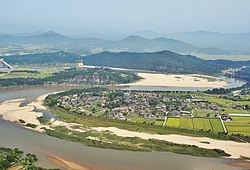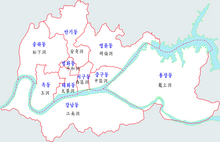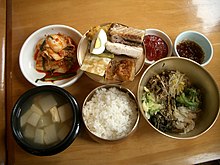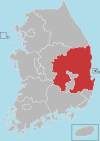Andong
Andong
안동시 | |
|---|---|
| Korean transcription(s) | |
| •Hangul | 안동시 |
| •Hanja | AnĐôngThị |
| •Revised Romanization | Andong-si |
| •McCune-Reischauer | Andong-si |
 An aerial view ofHahoe Folk Village | |
 Location in South Korea | |
| Coordinates:36°33′33″N128°43′44″E/ 36.55917°N 128.72889°E | |
| Country | |
| Region | Yeongnam |
| First mention | 930 |
| City status | 1963 |
| Administrative divisions | 1eup,13myeon,10dong |
| Government | |
| • mayor | Ki Chang Kwon (권기창) |
| Area | |
| • Total | 1,590.91 km2(614.25 sq mi) |
| Elevation | 139 m (456 ft) |
| Population (November, 2022) | |
| • Total | 154,860 |
| • Density | 97/km2(250/sq mi) |
| • Dialect | Gyeongsang |
| Demonym | Andongite |
| Time zone | UTC+9(Korea Standard Time) |
| Postal code | 760003-760944 |
| Area code | (+82) 054 |
| Website | Official website |
Andong(Korean pronunciation:[an.doŋ]) is acityin South Korea, and the capital ofNorth Gyeongsang Province.It is the largest city in the northern part of the province with a population of 167,821 as of October 2010. TheNakdong Riverflows through the city. Andong is a market centre for the surrounding agricultural areas.
Since the 1970s Andong has developed rapidly, although the population has fallen by nearly seventy thousand as people have moved away toSeoul,Busan,Daeguand other urban centres. In the late 1990s and early 2000s it became a tourism and cultural center.
Andong is known as a centre of culture andfolk traditions.The surrounding area maintains many types of traditions and the Andong Folk Festival is held in mid October every year. One of the most famous aspects of these cultural festivities are the Andongmasks.
Andong National University,specialising in education and Korean folklore, has grown rapidly since the 1970s. Other tertiary institutions includeAndong Science CollegeandCatholic Sangji College.
History
[edit]
Around 1 BC, Andong was founded by theJinhanpeople, and it was known as Gochang. During theThree Kingdoms period,the area was controlled by theSillakingdom. TheBattle of Gochangin 930 was fought here betweenHubaekjeforces and theGoryeoarmy led byWanggeon,who won control of the city and renamed it Andong.
After the ascent of theJoseon dynastyto the throne of Korea, Andong became a centre ofConfucianism.The area was extremely conservative for a long time and produced many leading confucian scholars.Toe-gye Yi Hwang(1501–1570), one of the most prominent of all Korean scholars, came from Andong. Yi Hwang retired back to his homeland late in life and started the establishment of the great Confucian academyDosan Seowonthere, which was finished after his death. During this period Andong and its principal families were influential within Korean political circles, of which the three notable families were the Andong Kim, Andong Jang and AndongKwonclans.
After the 16th century Andong became less influential until the early 19th century, when a marriage of the localKimfamily resulted in strong influence on the royal family.
Andong was the site of intense fighting during theKorean Warin the early 1950s, theBattle of Andong.Although the city was almost destroyed, it was quickly rebuilt. In 1976 theAndong Damwas built, providing the city with a reliable source of electricity.
In 1999,Her Majesty the Queen Elizabeth IIof the United Kingdom celebrated her 73rdbirthdayin the city.[1]There is an exhibit dedicated to this historic visit at Hahoe folk village museum.Andong sojuis made using traditional methods that are centuries old unlike its popular modern counterparts. It is protected by government regulation to preserve authenticity and commands a steep premium in the marketplace.
Administrative divisions
[edit]

Andong is divided into 1 eup, 13 myeon and 10 dong. The following is a list of eup, myeon and dong:
| Name | Hangeul | Hanja |
|---|---|---|
| Pungsan-eup | 풍산읍 | Phong sơn ấp |
| Waryeong-myeon | 와룡면 | Ngọa long diện |
| Bukhu-myeon | 북후면 | Bắc hậu diện |
| Seohu-myeon | 서후면 | Tây hậu diện |
| Pungcheon-myeon | 풍천면 | Phong xuyên diện |
| Iljik-myeon | 일직면 | Nhất trực diện |
| Namhu-myeon | 남후면 | Nam hậu diện |
| Namseon-myeon | 남선면 | Nam tiên diện |
| Imha-myeon | 임하면 | Lâm hà diện |
| Giran-myeon | 길안면 | Cát an diện |
| Imdong-myeon | 임동면 | Lâm đông diện |
| Yean-myeon | 예안면 | Lễ an diện |
| Dosan-myeon | 도산면 | Đào sơn diện |
| Nokjeon-myeon | 녹전면 | Lộc chuyển diện |
| Junggu-dong | 중구동 | Trung khu động |
| Myeongryun-dong | 명륜동 | Minh luân động |
| Yongsang-dong | 용상동 | Long thượng động |
| Seogu-dong | 서구동 | Tây khu động |
| Taehwa-dong | 태화동 | Thái hoa động |
| Pyeonghwa-dong | 평화동 | Bình hòa động |
| Angi-dong | 안기동 | An kỳ động |
| Ok-dong | 옥동 | Ngọc động |
| Songha-dong | 송하동 | Tùng hạ động |
| Gangnam-dong | 강남동 | Giang nam động |
Local specialty foods
[edit]
Andong has famous local foods that originated in the city such asheotjesabap,Andong jjimdak,Andong soju(a rice wine),Andong sikhye(a punch),Geonjin guksu(a noodle dish), and saltedmackerel.[2]
Heotjesabap(헛제삿밥) is a variety ofbibimbap,served withsoy sauce(ganjang) instead of thegochujang(hot pepper paste) that is more commonly used.Heotjesa babconsists mainly of several types ofnamul(young sprouted vegetables) over white rice. It is also served with grilled fish, shark, andjeon(Korean pancake). The dish originated in Andong. The term,Heotjesa bapliterally means "dishes for fakejesa"that are ceremonies fordeath anniversaryandancestor venerationheld in Korea. The reason it is considered fake is that it is not covered in incense ash, as would happen to any food sacrificed in a jesa ritual.
Andong jjimdakis a variety ofjjim(a Korean steamed or braised dish), made with chicken,cellophane noodles,and various vegetablesmarinatedin aganjang(Korean soy sauce) based sauce. The name literally means "steamed chicken of Andong."[3][4]There are many speculations on the origins of the dish. One is that the it is a specialty food of the inner rich village of Andong during theJoseon period,prepared and eaten for special occasions.[5]The more likely explanation is that during the 1980s in theDak golmok(닭골목,literally "chicken alley" ) of the "Andong Old Market," restaurant owners there made a dish including ingredients that regulars demanded, which became the currentAndongjjimdak.[6]Restaurateurs in the area claim it was invented by five local old women who had limited chicken supplies and wanted to stretch it out.[7]The most plausible speculation among existing assumptions is that merchants of theDak golmokat the market created the dish to keep their position against the rapid expansion of Western fried chicken shops.[4]
Andong Sojuis a specialty of the region. It is made with natural ingredients, unlike mass-produced brands, it was historically used for medicinal purposes, and was developed during theSilla dynasty.The traditions of Andong Soju were almost lost during the '60s and '70s due to government legislation, but they were brought back by Cho Ok-hwa, the current skillholder. Andong soju was traditionally made by the wife of a household, and she passed down the secrets to her daughters-in-law.[8][9]
Mackerelis another popular local delicacy. Caught downstream where theNakdong Rivermeets the sea, in ancient times the fish would spoil before being brought further inland. Using special salting techniques, Andong was the furthest inland the fish could be brought, so aristocrats would travel to Andong specially for the salted fish.[10]
Sikhyeis a fermented rice punch served across Korea. The Andong variety, however, is particularly spicy, made with powdered red pepper, ginger, and radish. Sikhye containslactobacillus,a benign strain of bacteria found in the gastrointestinal tract, and often used as a digestive aid in dishes includingkimchi,yogurt, and sauerkraut, among others.[10]
Culture
[edit]Museums
[edit]- Andong Sojuand Traditional Food Museum
- Gyeongsangbuk-do Forest Science Museum
- Kwon Jeong Saeng Fairy Tale Museum
- Municipal Folk Museum
- Seonseonghyun Cultural Heritage Complex
- Traditional Cultural Contents Museum
Parks
[edit]- Gyemyeongsan Recreation Forest
- Amsan Pleasure Ground
Villages
[edit]- Andong Gunja Village
- Yeumteo Village
- Jirye Arts Village
- Hahoe Folk Village
Confuncian Academies
[edit]Mountains
[edit]- Gallasan Mountain
- Cheondeungsan Mountain
Monuments
[edit]- Gyeongsangbuk-do Independence Movement Memorial
Experiences
[edit]- Dosan Hot Spring
- Andong Maskdance Festival
- Hahoe Mask Dance.
- Hakgasan Hot Spring
- Top-bliss Golf Club
- Imhaho Camping Water Leisure Town
- HuGreen Golf Club
- Danho Sand Park Camping Site
- Danho Sand Park Camping Site
HuGreen Golf Club
- Top-bliss Golf Club
- Ontrepieum
Architecture
[edit]Historical
[edit]- Bongjeongsa,a Buddhist monastery
- Mukgye Seowon
- Nongam Jongtaek
- Andong imcheonggak
- Taesamyo
- Confucian Land
Modern
[edit]- Gyeongbuk Provincial Government Office
special product
[edit]- Wol Young Yakgwa
- Hahoe mask bread
Education
[edit]- Andong Manner School
- Advanced Center for Korean Studies
Sports
[edit]- Andong Gymnasium
Visitor attractions in Andong
[edit]TheHahoe Folk Villageis perhaps the most notable folk village in South Korea. This village is listed by the South Korean government withUNESCOas aWorld Heritagesite withYangdong Folk Villagein 2010.
Andong is also a home of Confucian studies and academies during theJoseon Dynasty.The notable examples ofseowon,or Confucian academy areDosan Seowonthat enshrinesYi Hwang,Byeongsan SeowonforYu Seong-ryong,Imcheon SeowonforKim Seong-il,Gosan Seowon,Hwacheon Seowonand others. Other notable visitor destinations areSisadan,Jirye Artists' Colony,Bongjeongsatemple andAndong Icheondong Seokbulsangaka Jebiwon Stone Buddha.
Andong also hasAndong Dam.In the area where Andong Dam is located, there is a monument to the Andong Samil Movement to honor theMarch 1st Movement.In addition, there are Wonmom theme parks and Unbu parks.[11]
Festival
[edit]Climate
[edit]Andong has ahumid continental climate(Köppen:Dwa), but can be considered a borderlinehumid subtropical climate(Köppen:Cwa) using the −3 °C (27 °F) isotherm. The city is located in the mountainous region of central South Korea and is part of the temperate climate. Temperatures vary widely, fog is high at 79 days per year, seasonal winds are northwest in winter and northwest in summer.[12]
| Climate data for Andong (1991–2020 normals, extremes 1973–present) | |||||||||||||
|---|---|---|---|---|---|---|---|---|---|---|---|---|---|
| Month | Jan | Feb | Mar | Apr | May | Jun | Jul | Aug | Sep | Oct | Nov | Dec | Year |
| Record high °C (°F) | 13.2 (55.8) |
23.2 (73.8) |
25.5 (77.9) |
32.1 (89.8) |
35.1 (95.2) |
35.7 (96.3) |
38.9 (102.0) |
38.8 (101.8) |
34.8 (94.6) |
29.0 (84.2) |
25.1 (77.2) |
17.0 (62.6) |
38.9 (102.0) |
| Mean daily maximum °C (°F) | 4.0 (39.2) |
7.0 (44.6) |
12.6 (54.7) |
19.5 (67.1) |
24.7 (76.5) |
27.9 (82.2) |
29.5 (85.1) |
30.1 (86.2) |
25.8 (78.4) |
20.5 (68.9) |
13.0 (55.4) |
5.9 (42.6) |
18.4 (65.1) |
| Daily mean °C (°F) | −1.8 (28.8) |
0.8 (33.4) |
6.0 (42.8) |
12.4 (54.3) |
17.8 (64.0) |
21.9 (71.4) |
24.8 (76.6) |
25.1 (77.2) |
20.0 (68.0) |
13.5 (56.3) |
6.4 (43.5) |
−0.1 (31.8) |
12.2 (54.0) |
| Mean daily minimum °C (°F) | −7.2 (19.0) |
−5.1 (22.8) |
−0.2 (31.6) |
5.5 (41.9) |
11.2 (52.2) |
16.5 (61.7) |
21.0 (69.8) |
21.2 (70.2) |
15.5 (59.9) |
8.0 (46.4) |
1.0 (33.8) |
−5.3 (22.5) |
6.8 (44.2) |
| Record low °C (°F) | −20.4 (−4.7) |
−18.6 (−1.5) |
−11.5 (11.3) |
−4.3 (24.3) |
1.8 (35.2) |
6.1 (43.0) |
11.8 (53.2) |
12.0 (53.6) |
4.0 (39.2) |
−4.2 (24.4) |
−11.8 (10.8) |
−16.0 (3.2) |
−20.4 (−4.7) |
| Averageprecipitationmm (inches) | 16.7 (0.66) |
24.9 (0.98) |
44.5 (1.75) |
74.0 (2.91) |
85.1 (3.35) |
123.1 (4.85) |
235.2 (9.26) |
226.4 (8.91) |
119.8 (4.72) |
46.5 (1.83) |
30.9 (1.22) |
18.6 (0.73) |
1,045.7 (41.17) |
| Average precipitation days(≥ 0.1 mm) | 4.9 | 4.9 | 7.2 | 8.0 | 8.7 | 9.6 | 14.2 | 13.9 | 9.0 | 5.7 | 6.2 | 5.5 | 97.8 |
| Average snowy days | 5.5 | 3.7 | 2.6 | 0.3 | 0.0 | 0.0 | 0.0 | 0.0 | 0.0 | 0.0 | 0.8 | 4.1 | 17 |
| Averagerelative humidity(%) | 59.9 | 57.3 | 56.8 | 55.4 | 61.0 | 68.8 | 77.5 | 77.7 | 76.5 | 72.7 | 68.2 | 62.7 | 66.2 |
| Mean monthlysunshine hours | 194.8 | 193.8 | 214.1 | 222.3 | 235.2 | 200.4 | 161.9 | 172.8 | 157.0 | 188.5 | 166.7 | 185.1 | 2,292.6 |
| Percentpossible sunshine | 59.9 | 59.7 | 54.1 | 55.6 | 51.4 | 43.4 | 33.4 | 39.8 | 40.5 | 52.0 | 53.5 | 58.9 | 49.3 |
| Source:Korea Meteorological Administration(percent sunshine 1981–2010)[13][14][15] | |||||||||||||
Gallery
[edit]-
Sisadan
-
Hahoe Dance Mask
-
Andong Gu Market, food market in downtown Andong
-
Woryeonggyo,Bridge in Sang-a dong, Andong
Sister cities
[edit] Bacolod, Negros Occidental,Philippines[16]
Bacolod, Negros Occidental,Philippines[16] Sagae, Yamagata Prefecture,Japan[17]
Sagae, Yamagata Prefecture,Japan[17] Pingdingshan(Henan) andQufu(Shandong), China[citation needed]
Pingdingshan(Henan) andQufu(Shandong), China[citation needed]
Partnership of kindness with:
 Holon,Israel[citation needed]
Holon,Israel[citation needed]
People from Andong
[edit]- Cho Yoon-jeong(born 1979), tennis player
- Ji Han-jae(born 1936), martial artist,Hapkidograndmaster and actor
- Lee Elijah(born 1990), actress
- Lee Jae-myung(born 1964), Governor ofGyeonggi Province
- Kim Jin-kyu(1922–1998), actor, film director and producer
- Kim Jong-gil(1926–2017), poet
- Kim Mi-soon,Paralympic archer[18]
- Park Ki-woong(born 1985), actor
- Park So-yeon(born 1987), singer, actress andK-popidol(T-ara)
- Kim "Canna" Chang-dong(born 2000), professionalLeague of Legendsplayer, currently a top laner forDWG KIA.
- Lee Dong-heon (born 1995), singer andK-popidol(VERIVERY)
- Kim Byung-chul (born 1974), South Korean actor.
See also
[edit]External links
[edit] Andongtravel guide from Wikivoyage
Andongtravel guide from Wikivoyage- City government website
- Andong: Official Site of Korea Tourism OrgArchived2014-11-06 at theWayback Machine
References
[edit]- ^"Queen Elizabeth cherishes memory of birthday party in Korea".The Korea Times.June 6, 2016.RetrievedJune 20,2018.
- ^"Archived copy".Archived fromthe originalon 2012-04-02.Retrieved2011-11-09.
{{cite web}}:CS1 maint: archived copy as title (link) - ^"Genuine and Timeless Treasures in Confucian Country".Korea Tourism Organization.Archived fromthe originalon 2012-06-30.
- ^ab안동찜닭(in Korean).Doosan Encyclopedia.[permanent dead link]
- ^Yun Tae-ha (윤태하) (2008-09-04).희동이세상 - 안동의 전통음식(in Korean). andong.net. Archived fromthe originalon 2011-07-23.Retrieved2009-03-11.
- ^"Andong, the Home of Confucianism and the Noble Class".Archived fromthe originalon 2012-06-30.
- ^"Jungang Hansik: A Culinary Voyage through Korea's Heartland | the Korea Blog".Archived fromthe originalon 2012-03-12.Retrieved2011-11-09.
- ^"Untitled Document".Archived fromthe originalon 2011-07-07.Retrieved2011-11-09.
- ^"Archived copy".Archived fromthe originalon 2012-04-02.Retrieved2011-11-09.
{{cite web}}:CS1 maint: archived copy as title (link) - ^ab"Archived copy".Archived fromthe originalon 2012-04-02.Retrieved2011-11-09.
{{cite web}}:CS1 maint: archived copy as title (link) - ^"안동관광정보센터".www.tourandong.com.Retrieved2019-05-20.
- ^"안동시",위키백과, 우리 모두의 백과사전(in Korean), 2019-01-11,retrieved2019-05-02
- ^ "Climatological Normals of Korea (1991 ~ 2020)"(PDF)(in Korean). Korea Meteorological Administration. Archived fromthe original(PDF)on 29 January 2022.Retrieved4 April2022.
- ^ 순위값 - 구역별조회(in Korean). Korea Meteorological Administration.Retrieved4 April2022.
- ^ "Climatological Normals of Korea"(PDF).Korea Meteorological Administration. 2011. Archived fromthe original(PDF)on 7 December 2016.Retrieved8 December2016.
- ^"City to forge ties with South Korea, Indonesia".Sun.Star Bacolod. 2008-09-27. Archived fromthe originalon 2008-10-01.Retrieved2008-09-28.
- ^"International Exchange".List of Affiliation Partners within Prefectures.Council of Local Authorities for International Relations (CLAIR). Archived fromthe originalon 22 December 2015.Retrieved21 November2015.
- ^"Kim Mi Soon".World Archery.Retrieved4 October2019.







![Woryeonggyo [ko], Bridge in Sang-a dong, Andong](https://upload.wikimedia.org/wikipedia/commons/thumb/d/df/Weolyeonggyo_Bridge_01.jpg/120px-Weolyeonggyo_Bridge_01.jpg)
